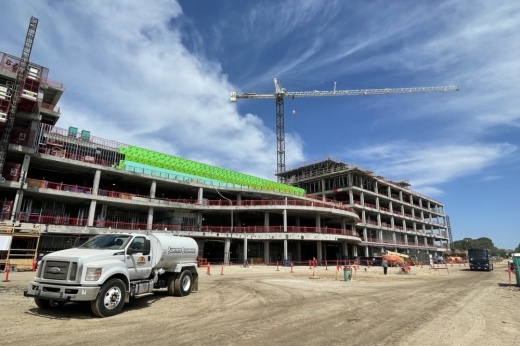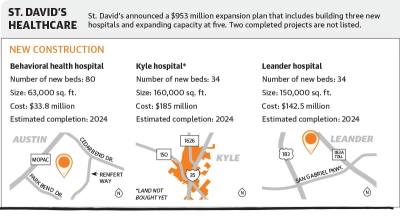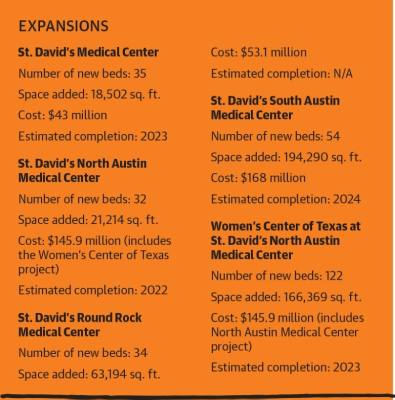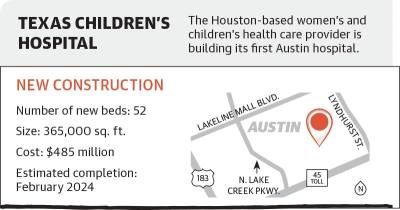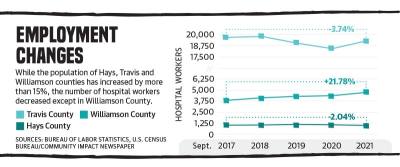Combined, three major health care systems are investing almost $2.5 billion in physical infrastructure to increase access to services and meet the needs of the growing region.
Hospital officials said the additional space is necessary to care for the population of a rapidly expanding region, with Williamson and Hays counties ranking as some of the fastest growing in the nation. Andy Davis, the CEO for Ascension Texas, a major health care system that includes Ascension Seton and Dell Children’s, said based on projections, within 10 years the metro area will have a 1,200-bed deficit.
“The great thing about Central Texas is the community is growing in every direction, and so it presents a unique opportunity for us to make sure that we’re doing all we can to be present in a way that keeps families close to home and together,” Davis said.
Bringing care to the community
One hospital system making a major investment in physical infrastructure is St. David’s HealthCare, which announced in February an expansion plan totaling nearly $1 billion.
The plan includes opening new hospitals in 2024 in Kyle and Leander—two cities St. David’s President and CEO David Huffstutler characterized as “rapidly growing.”
While the Leander hospital will be located on St. David’s existing property, which al•ready includes a free-standing emergency department and medical office building, the system is working to purchase land for the Kyle hospital.
Because building and expanding hospitals takes several years, Huffstutler said St. David’s tries to forecast where the demand for health care services will be.
“We know if we started today, there will be a lot more growth in these communities over the next two and half years as we’re trying to get this capacity online, so we have to start early in anticipation of what it’ll look like over that horizon,” Huffstutler said.
In the next 20 years, the population of Hays and Williamson counties is projected to approximately double to 500,000 and 1.2 million residents, respectively, according to data compiled by the Austin Chamber of Commerce. Travis County is expected to total 1.8 million residents by 2040.
Davis said this growth was top of mind when Ascension Texas completed expansions at Ascension Seton Williamson Hospital in Round Rock and Ascension Seton Hays Hospital in Kyle in February. Ascension is also planning to open a women’s tower at Ascension Seton Medical Center Austin in fall 2024.
Health care leaders also cited a desire to further develop their services and care for underserved populations as other reasons to grow.
Dr. Rob Watson, chief medical officer for the Greater Austin region at Baylor Scott & White Health, said two of the three new hospitals it opened in 2019 were located in cities that previously did not have a hospital—Buda and Pflugerville.
“We look for opportunities where we think there are growing health care needs that are not being met in the community,” Watson said.
Huffstutler said the 80-bed behavioral, or mental health, hospital St. David’s is building near the North Austin Medical Center is an example of the system adding to its services. He said access to behavioral health care is lacking throughout the nation and state, but he said the northern portion of the Central Texas community has even fewer available resources. The $33.8 million facility will open in 2024.
St. David’s is also investing in other expansions at its North and South Austin and Round Rock hospitals.
Prioritizing pediatrics
Davis said the growth of Central Texas has caused an especially sharp increase in demand for pediatric care. He and other health care officials noted how young families are moving to the area for employment opportunities.
In an effort to meet this need, two different systems are building pediatric hospitals in North Austin about a mile away from one another.
Slated to open in April 2023, Dell Children’s Medical Center North will be located near the intersection of Avery Ranch Boulevard and 183A Toll. The facility will start with 36 beds and have room to grow, Dell Children’s President Christopher Born said.
“The travel time to get down to Dell Children’s Central in the Mueller neighborhood was getting extremely elongated, so our thought process of building the North hospital was to provide increased access to the expert care Dell Children’s is known for,” Born said.
Dell Children’s is also increasing capacity at its main hospital by building a 96-bed fourth patient tower and expanding its neonatal intensive care unit.
Texas Children’s Hospital is building the other pediatric facility in Northwest Austin. This hospital, located near US 183 and SH 45 N, represents the Houston-based system’s first in Austin.
The 52-bed hospital is expected to open to patients in February 2024, Texas Children’s Executive Vice President Michelle Riley-Brown said.
She said she hopes the hospital is a resource to the growing North Austin suburbs where she believes there is enough demand for both pediatric facilities.
“By having a hospital here, families and women and children will have choices as to health care,” Riley-Brown said. “We think it’s going to complement and actually benefit Austin as a whole.”
Texas Children’s purchased land in 2019 near I-35 and SH 45 SE in South Austin, but has not announced development plans at this time.
Born said while only a portion of the population will need hospital services at a given time, both children and adults will need primary care services. As such, most health systems are adding and acquiring physicians to provide this care.
Austin Regional Clinic, an Austin-based provider of primary and outpatient multispecialty services, added clinics in Dripping Springs, Georgetown and Liberty Hill in the last three years, and it now offers 32 locations throughout Central Texas.
ARC CEO Dr. Anas Daghestani said where and when ARC builds clinics is driven in large part by where patients and staff live. He said next year ARC is opening clinics in Westlake, Elgin and Goodnight Ranch in Southeast Austin.
“We’re trying to make sure that we provide access as our patients are moving into those [outlying] communities,” Daghestani said.
Scaling challenges
Rapidly scaling up physical footprints poses a number of challenges to health care systems, namely staffing, officials said. The new Texas Children’s Hospital alone is expected to require 700-800 employees, and the Kyle and Leander St. David’s hospitals will each create 200 jobs.
Statewide, health care workers are already in high demand and short supply as many left the workforce during the pandemic.
Exacerbating the problem is a shortage of registered nurses. From 2018-32 demand for nurses in Central Texas is projected to grow by 45.9% while the supply is expected to increase by 38.1%, creating a deficit of 8,424 nurses across a 30-county region, according to Texas Department of State Health Services data.
However, leaders said the long lead time for construction allows them to recruit and train staff ahead of a new facility opening.
“I think we are all out there trying to figure out how do we grow in Central Texas—how do we get the resources and the staff we need to be able to provide for patients in our communities?” Watson said.




